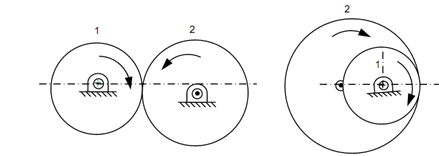Simple Gear Train:
In this gear train, there are series of gears that are capable of receiving & transmitting motion from one gear to another. They might mesh internally or externally. Each of the gear rotates around separate axis fixed to the frame. Given fig shows two gears in internal meshing and external meshing.
Assume t1, t2 is number of teeth on gears 1 & 2.

(a) External Meshing (b) Internal Meshing
Assume N1, N2 as speed in rpm for gears 1 & 2.
The two meshing gears in external meshing rotate in opposite sense while in internal meshing they rotate in similar sense. In simple gear train, there may be more than two gears also as illustrated in Figure .

Simple Gear Train
Consider N1, N2, N3,............. be speed in rpm of gears 1, 2, 3,4 . . . etc., and t1, t2, t3, . . . be number of teeth of respective gears 1, 2, 3,4 . . . , etc.
In this gear train, gear 1 is input gear, gears 2, 3 are intermediate gears and gear 4 is output gear. The gear ratio of the gear train is given by following
Gear Ratio =


Thus,

This expression shows that the intermediate gears contain no effect on gear ratio. These intermediate gears fill the space among input & output gears.